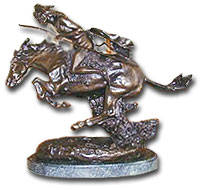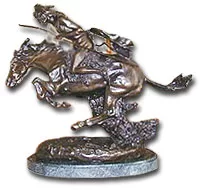A quick quiz: A print is to a painting as a blank is to a sculpture?
If you guessed “bronze,” you’re right. Both prints and bronzes are multiples of original works.
Because each one isn’t unique, bronzes aren’t as expensive as many original sculptures. And since they’re multiples, the auction market has never been very strong for most pieces. However, interest in bronzes has steadily risen in the last few decades.
Prices for some bronzes have gone from hundreds to thousands of dollars. We explore the potential dangers in bronze collecting — given the level of investment.
Watch for spelter
There is bronze and then there is spelter, which is zinc with a bronze finish. It’s usually not as well detailed or finished, but many people mistake it for bronze. Real bronze sculpture weighs more and is richer in detail, color, and sheen. Unfortunately, buyers don’t always have a real bronze to compare the spelter to.
It’s analagous to when someone has a silver-plated teapot and thinks it is a sterling silver teapot. It looks like silver, but it’s not silver. Spelter looks like bronze, but it’s not bronze.
Reproduction of a bronze Remington sculpture


Learn the history
The worst part of the bronze business is the enormous number of reproductions of works by the most popular sculptors, such as Frederic Remington. A recast reproduction of a Remington might sell in an antiques shop for $2,000, while the original might bring $250,000 at auction.
If you know about sculpture, you no doubt know that Remington’s were made exclusively in the Roman Bronze Works in Brooklyn, and only on a commission basis. You know that $2,000 is too good to be true, and you’re not going to fall for it. Most people don’t find that out until after they buy the sculpture.
Know the age
Technological innovations during the 19th-century allowed many original wax models to survive the casting process. Consequently, foundries were able to issue editions of bronzes even after the artists died.


Fernando Boteros‘ Reclining Woman.
The more a mold is used, the more likely the details of a sculpture will change. Delicate pieces break and are reattached, and worn areas are recarved. In some versions of Remington’s “Mountain Man,” the trapper’s trigger finger is extended, while in others it isn’t. Often there are records of a well-known artist’s work that indicate which details have changed.
Some fakes are made by forgers who sculpt their own versions. Still others are cast directly from an authentic bronze, rather than a mold. They’re usually smaller and less detailed.
Check the patina
Vintage bronzes can have a patina which is the result of artificial and natural processes. When a bronze is cast, artificial coloring is applied through a chemical process. Then over the years, chemicals in the air and the touch of human hands can alter this surface to create a natural patina.
Contemporary fakes are painted instead of having a true patina. Eventually the paint flakes off — a real patina doesn’t flake or scratch off easily.
Fernando Botero
Fernando Botero, a prolific Colombian painter and sculptor was the most celebrated and successful living Latin American artist of the 21st century. Suffice it to say, you know a Botero when you see one.
Born in Medellín, Colombia in 1932, Botero left matador school to become an artist; traveling through Europe on a scholarship as a teenager, he found inspiration in the works of masters such as Giotto, Piero della Francesca, Vermeer and Ingres. In the 1960s he moved to New York, where he refined his signature ‘boterismo’ style marked by exaggerated, voluptuous forms, masterful painterly technique and a sly sense of humor.





